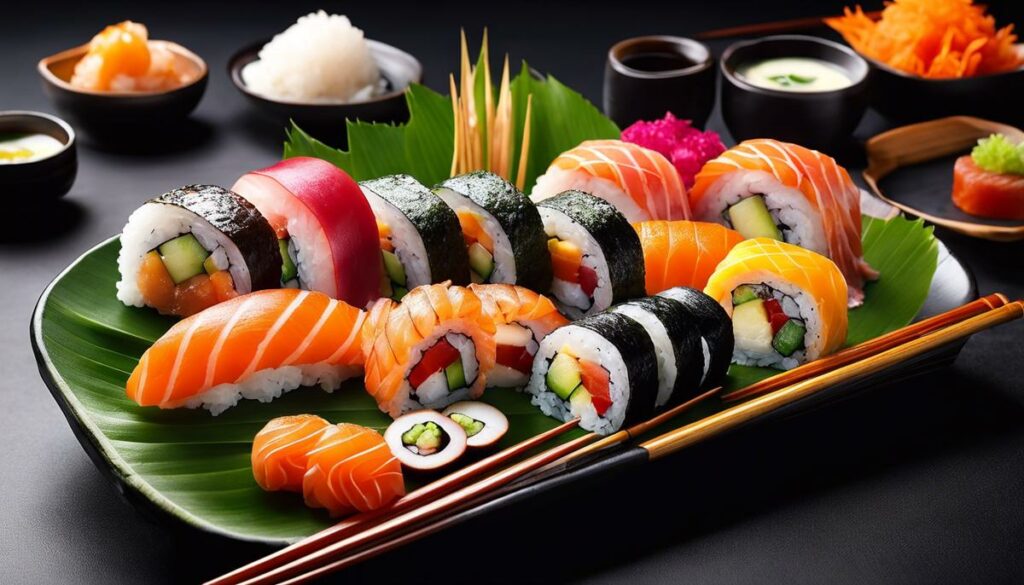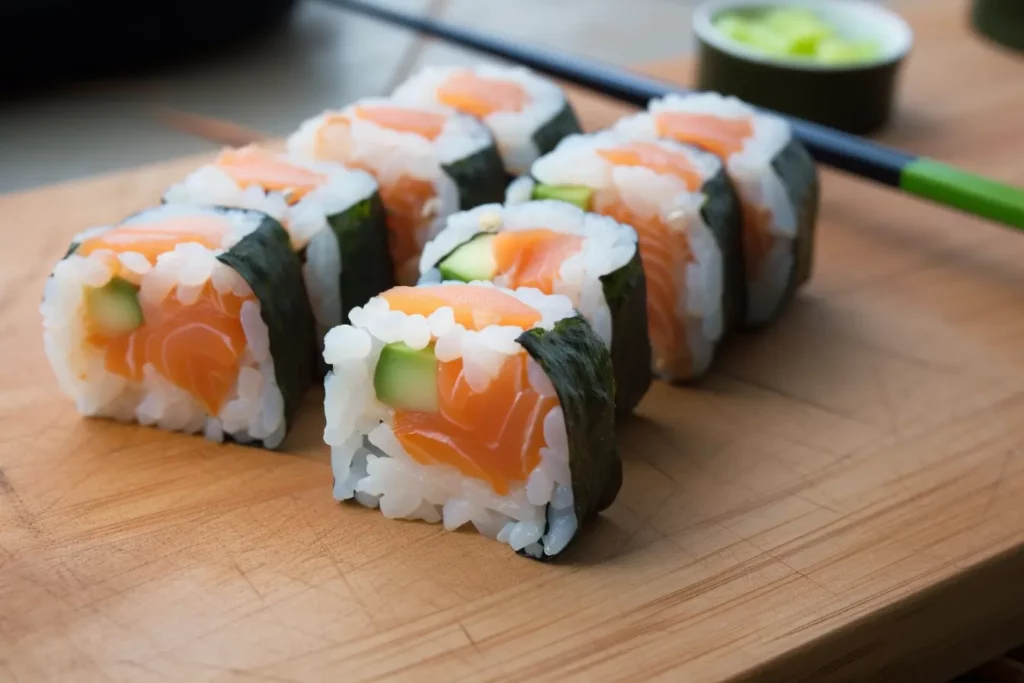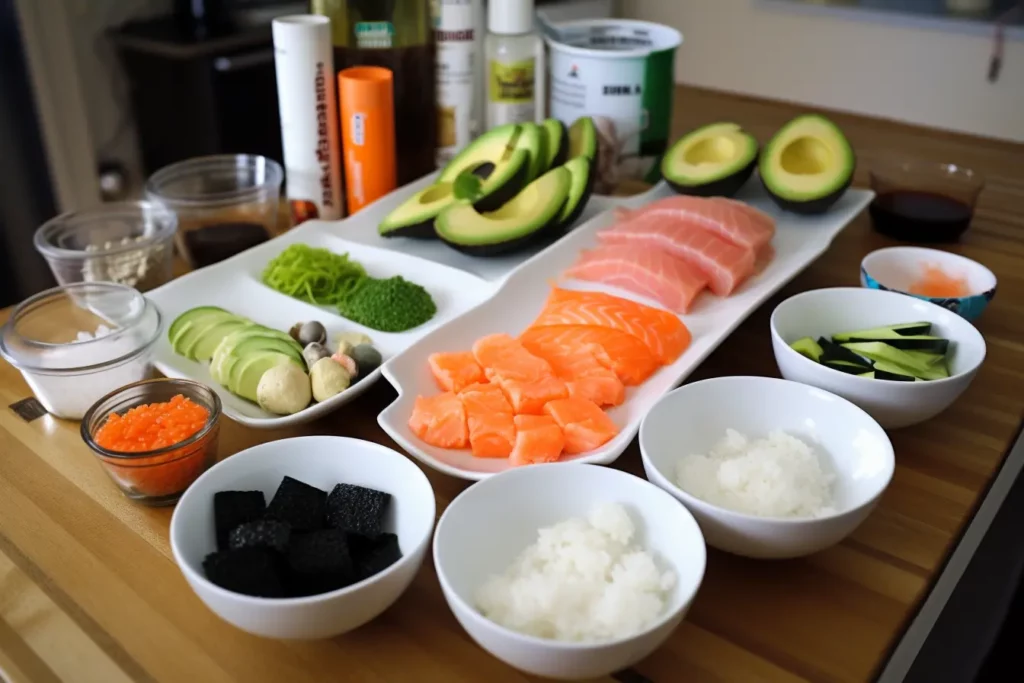Sushi, the world-famous delicacy, traces its roots back to a complex and rich history that spans continents and centuries. Originally introduced to Southeast Asia as a simple method of preservation, sushi has evolved over time into a work of art in gastronomy that appeals to both the senses and the palate. With regional influences and political and social factors contributing to its design, the history of sushi is a fascinating journey through cultures and ages. Let’s explore together and explore the different facets of sushi from its humble beginnings to the modern variety we enjoy today.
The roots of sushi
Title: “The story still told: Where does the fascinating train of sushi cuisine begin?”
Requires the finest craftsmanship, precise presentation, and an impeccable experience, sushi is, without a doubt, a masterpiece of culinary indulgence. However, this iconic dish, which is so present in the global gourmet scene today, has a deep history that deserves more attention.
The journey of sushi actually begins quite modestly. In the eighth century, during the Heian period, sushi was first mentioned in ancient Japanese texts. At the time, however, it was a method of preserving fish by pickling it in fermented rice. The rice was then discarded while the fish was enjoyed – a stark contrast to the rigid focus on perfectly seasoned rice in today’s sushi cuisine.
Consider Edo (modern-day Tokyo) in the 19th century. Edo Harbour was buzzing with a variety of fresh fish and seafood. This gave rise to the “fast food” trend in Japan, the birth of “Edo-Mae”, today’s sushi as we know it. It provided traders, fishermen and artisans with a quick, nutritious meal. The rice was seasoned with rice vinegar to protect the fish from spoilage, which allowed for a longer shelf life.
However, the expression of aesthetics has always been a crucial aspect in the history of sushi. One might think that the pretty sushi presentation was established as early as the Edo period to attract their customers. But the real transformation of the sushi world, where art and cuisine have fused seamlessly, has been the invention of “nigiri sushi.” Master chef Hanaya Yohei coined this style, in which a handful of rice was topped with a thin strip of fish or seafood.
In today’s era, sushi is a worldwide phenomenon that exists in almost every conceivable variation. Whether it’s futomaki, tempura or nigiri, the charisma and experience of sushi consumption is second to none. The aesthetic presentation, the craftsmanship and the refined taste; Sushi is a testimony to the art that is life itself.
So the question “Where does the history of sushi begin?” isn’t just a preoccupation with chronological order – it’s an invitation to explore the combination of culture, history, and culinary art embodied in every single piece of sushi. It is a reminder of the journey we have taken as a society and of the development that is taking place individually and collectively. In short, it is an acknowledgment of who we are and who we can be. So that’s how the story begins, and it’s going to continue in an exciting way…

The Evolution of Sushi in Japan
In the ongoing history of sushi, a remarkable chapter is formed in the confrontations between tradition and modernity. Despite its deep cultural roots, sushi is an ever-evolving culinary performance that dynamically responds to current trends and global influences.
The beginning of the twentieth century was marked by a refinement of sushi techniques and presentations, coupled with a growing recognition and appreciation of sushi as an art form. It shifted from the street to specialized sushi restaurants, where renowned sushi masters realized their individual styles and interpretations.
With increasing industrialization and the faster way of life of the twentieth century, sushi was further adapted with the invention of “maki sushi” (sushi rolls). The handy roll was convenient for quick consumption and made sushi attractive to a larger market.
The post-war period of the twentieth century brought with it explosive international expansion of sushi, with it becoming particularly popular in Western countries such as the United States. Here, local ingredients were incorporated into traditional sushi preparation, leading to the creation of “fusion sushi,” such as the infamous California and Philadelphia rolls.
With the rise of the global health and fitness movement over the past few decades, sushi has once again gained popularity. It is now recognized as a healthy, protein-rich and at the same time delicate meal.
Sushi remains true to its essence despite the changes brought about by time and culture. The closeness to nature, the craftsmanship, the respect for the ingredients and the taste are preserved. Sushi thus constantly demonstrates its consistency, relevance and adaptability in the changing world of gastronomy.
As a symbol of Japanese culture and art, as well as a representative delicacy of Japanese cuisine, sushi continuously tells its unique story, which preserves both traditional values and demands the contemporary. It doesn’t take long to realize that sushi is much more than just a dish—it’s a reflection of Japanese history, culture, and artistic expression. This is the true sushi heritage that is passed down from generation to generation, and which makes it so attractive and fascinating in its history.

Globalization and the impact on sushi
Looking at the global landscape, globalization has drastically changed the shape and fabric of sushi. In the past, sushi was enjoyed exclusively in Japan, but thanks to the increasing mobility of people and the willingness to explore new cultures and foods, sushi has been reimagined and welcomed into the kitchens of numerous countries.
Through modernization, sushi has made the transition from a traditional, strictly regulated kitchen practice to an internationally accepted and popular dish. This includes adapting to global trends and taste preferences. For example, the “California roll” developed in the United States and quickly became a staple of sushi menus worldwide. This shift shows how sushi can incorporate nutritious ingredients and flavors from different cultures to create accessible and appealing variations.
However, the impact of globalization on sushi doesn’t end with its ingredients. The sushi industry has also been influenced by the shift from manual labor to machine production. The introduction of sushi roll machines in the mid-20th century has facilitated production and enabled massive quantities of sushi for the growing global market. These industrial changes have had both positive and negative effects. On the plus side, it has made sushi more accessible worldwide. On the negative side, these changes often lead to a loss of the traditional sushi-making art.
In many ways, sushi is a reflection of our globalized world. It symbolizes the growing influence of cultures on each other and the dynamic exchange of global ideas and flavors made possible by travel, technology, and the courage to be culinary creative. Today’s sushi, whether traditional style or creative fusion dish, presents itself as a delicious marriage of history, culture and artistry that originated in Japan and is now enjoyed worldwide.
Whether it’s a simple maki roll or an artfully prepared sashimi, the intangible value of sushi lies in its ability to connect us across the boundaries of languages and cultures. Globalization has made it possible for a small Japanese specialty to become a modern, global phenomenon that delights and excites people all over the world. Thus, sushi has not only evolved, but has become a ubiquitous expression of shared enjoyment and mutual cultural understanding.
Not to mention the enduring popularity of sushi due to its recognized health benefits. Sushi is often seen as a high-protein, low-calorie option with high-quality fatty acids from the types of fish used. Nutrition-conscious consumers appreciate these benefits and help increase the popularity of sushi worldwide.
To put it simply, globalization has spread sushi all over the world, giving it a variety of shapes and flavors. And despite all the changes and adaptations, sushi remains a meaningful symbol of Japanese culture and its gastronomic artistry.

Photo by nicklbaert on Unsplash
Modern Sushi
All good things come in threes, and this principle is also relevant to our journey through the fascinating world of sushi.
After our examination of the origin and development of sushi, we now look ahead: What makes modern sushi and what does the future look like?
The beauty of sushi is that it keeps reinventing itself in its form. The term “modern sushi” stands for the integration of new elements and approaches into traditional preparation. Fusions with other styles of cuisine have their place these days, as do fish delivery services and sake pairing events. There has also been a trend towards vegetarian and even vegan sushi, which is a remarkable change considering that fish is the main ingredient in the original sushi preparation.
Speaking of ingredients, globalization has led to the use of more and more exotic ingredients in sushi preparation. Today, you can find everything from cheetos to foie gras in sushi rolls—not to mention the regional variations that score points with content like fried chicken in Nashville or kimchi in Seoul. Today’s sushi reflects the variety of flavors of the globalized world.
However, the ingredients are only one element of modern sushi. Machine processes are also finding their way into sushi production and transforming traditional craftsmanship. Sushi robots, which can produce maki rolls en masse, are in confrontation with the craftsmanship of the sushi master. Yet, despite these transformations, craftsmanship remains a central pillar of sushi culture.
For our vision of the future of sushi, we would like to conclude the discussion with a quote from Jiro Ono, who is considered the best sushi chef in the world: “The secret to success is to focus on the meanness and leave the rest to God.” Perhaps this best describes the future evolution of sushi: focusing on quality as we brace ourselves for an unknown future.
The fascination with sushi is not diminishing, because it is more than just a dish – it is a worldwide phenomenon, a culinary art form and a symbol of Japanese culture. Let us continue to celebrate and cherish this wonderful heritage together. Because sushi is not only food for the body, but also food for the soul.

After our extensive study of the development, diffusion and modernization of sushi, we can conclude that sushi is more than just a dish – it is a phenomenon that transcends cultures, tastes and traditions. Sushi, which once began as a simple form of preservation, has now developed into a mainstay of international gastronomy. With ever-changing trends, innovative fusions, and a strong emphasis on sustainable practices, the future of sushi seems bright and exciting. Considering its rich history, we can say with confidence that sushi will continue to delight people around the world with its unique charm, diverse shapes, and delicious flavor profiles.


